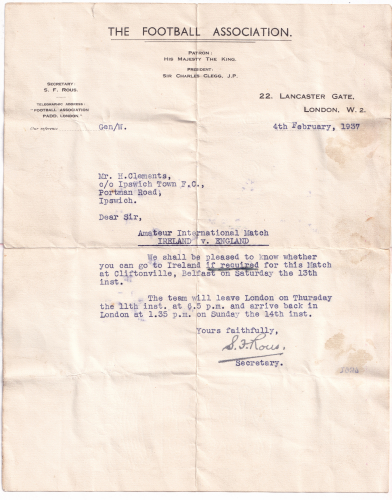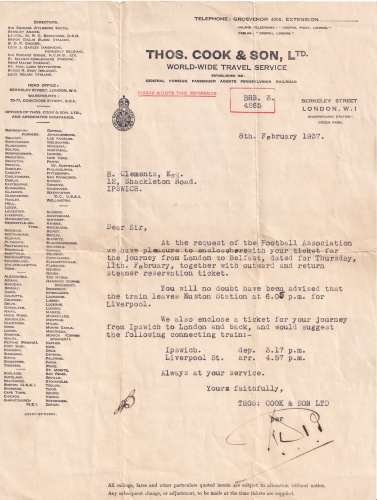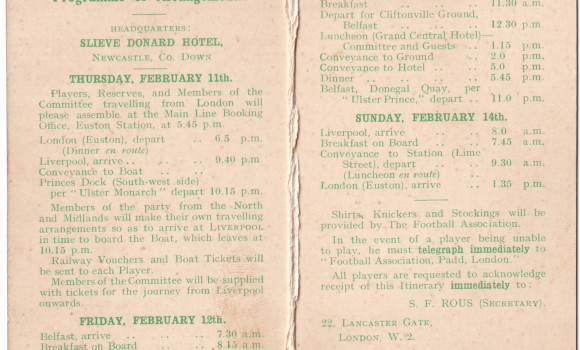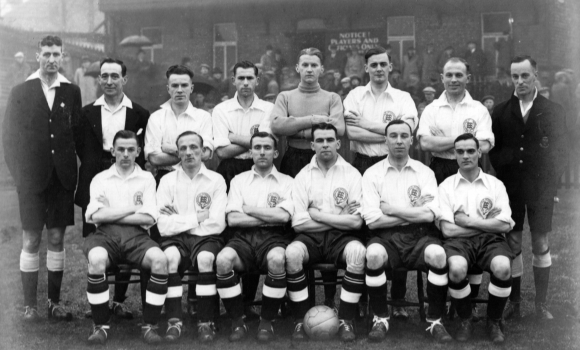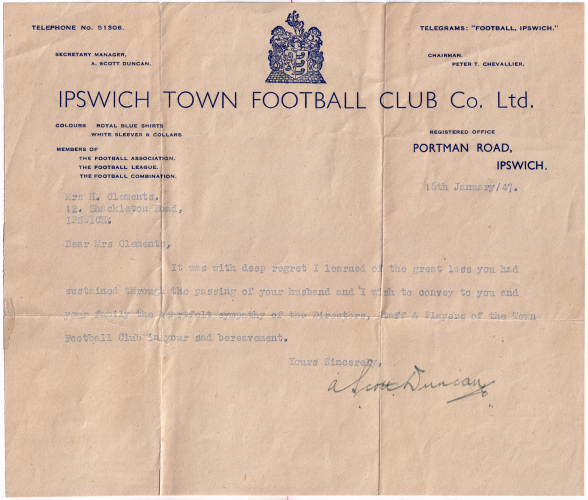Herbert Clements - Town's England International You’ve Probably Never Heard Of Tuesday, 21st Jun 2022 12:22 by James Ager Full-back Bailey Clements, who was recently released by Town and joined Chesterfield over the weekend, wasn’t the first member of his family to proudly represent their hometown club - his great-grandfather played for the Blues and also became the first Ipswich-born player to represent England, as James Ager recently discovered. Herbert Henry John Clements was born on 18th May 1908 and grew up in the family home in Cemetery Road in Ipswich. He had three sisters and was son to John, who worked as a lawnmower tester at Ransomes, Sims & Jefferies in the town, and Maud. However, when he was just six years old, Herbert tragically lost both his parents within a matter of months. After the passing of his mother in late 1914, only months later his father died from wounds sustained in the French commune of Estaires in World War I, and so he and his sisters went to live with their aunt and uncle in Alderman Road, just a stone's throw away from Portman Road. Herbert was educated at Ranelagh Road and then Northgate Grammar School for Boys. After leaving school, he went on to work for the Ipswich Gas Light Company as a gas fitter while he and his wife, Gladys, lived in Shackleton Road on the eastern side of Ipswich. Clements started his football career with Ipswich Life Brigade Old Boys and was part of their side that won Division Three of the Ipswich & District League in 1927-28. After a brief spell with Beccles Town, he joined Ipswich Town in 1929. He firmly established himself as outside left for both the Town and the Suffolk County senior sides, with the local press reporting that he would often bring the crowd to their feet with his 'bewildering' runs down the left wing. Clements played well in excess of 100 competitive first-team games for the club, plus many more for the reserve side, during its amateur days despite notable interest from Harwich & Parkeston in 1933. During the 10 seasons he spent at Portman Road, he was an important part of various Town teams that reached the finals of many local competitions. He won the Suffolk Senior Cup and the Southern Amateur League, although he was then a losing finalist in cup competitions on at least five occasions in just three seasons in the mid-1930s! In team photographs from his playing days, Clements almost always appeared seated on the far right-hand side of the group and this was no coincidence. Back then, the 11 players would face the camera as per their position in the team's playing formation, so players at the front of the picture would typically be the wide men and forwards and their position in the photo would represent the area of the pitch (right/centre/left) that they tended to occupy (click photos to enlarge).
In 1935, Clements was part of the Suffolk side that was defeated 6-1 by Arsenal - back then the top team in the land - at Portman Road in a game that marked the golden jubilee of the Suffolk Football Association. A year later, Town turned professional and while Clements featured for the reserves in the Eastern Counties League for a couple of seasons, he did make one professional appearance in November 1936. It was in a FA Cup fourth qualifying round match at Portman Road against Cambridge Town, watched by just over 8,500 people, and he scored the Blues' equaliser in a 2-1 win. “Nine minutes from the end,” a match report reads, “Ipswich were awarded a free-kick for a foul on Williams. Perrett put in a great shot which Whillock punched away, but Clements caught it on the half-volley and slammed the ball home.” Just 10 days later, Clements was included in an FA Amateur XI side for a game against Oxford University, which they won 5-1. The local press snippet reports that he “headed a lovely goal from a corner kick, and played an excellent game throughout”. Perhaps it was that performance that caught the eye of the selectors because in early February 1937, Clements received a letter from the then Secretary of the Football Association, Stanley Rous. This was followed a few days later by a letter and travel documents from Thomas Cook & Son Ltd.
On 13th February 1937, after a couple of days of travelling, Clements achieved the remarkable honour of becoming the first Ipswich-born player to play football for England when he gained his one and only amateur international cap in a 5-1 defeat against Ireland. The game was played in front of 10,000 people at Cliftonville Gardens in Belfast and it turned out to be England's heaviest ever defeat in an amateur international match.
The following year, Clements signed for Cambridge Town and was a regular in their side during the 1938-39 season, but his playing career was then brought to an end by World War II. He volunteered for the RAF and was sent to work as a fitter in an aircraft factory in Southampton, but during an air raid there he received an injury from a blast that weakened his heart. After later being admitted to hospital back in Ipswich for pleurisy, he sadly passed away on 11th January 1947, aged just 38. In the days and weeks following his death, various tributes were paid in local newspapers and his grieving wife received a touching letter from the then-Town manager, Scott Duncan. Most of the family remain living locally in the town, extremely proud of the achievements of Herbert Clements. And while one of Herbert's great grandsons has just ended his long association with Town, Bailey had been with the club since he was seven, his older brother Kyran - who has just re-signed for another season with Braintree Town in the National League South - keeps the family connection going as he's employed as player care officer within the Blues’ academy.  Bailey Clements
Photos: Clements family Please report offensive, libellous or inappropriate posts by using the links provided.
You need to login in order to post your comments |
Blogs 298 bloggersIpswich Town Polls[ Vote here ] |


